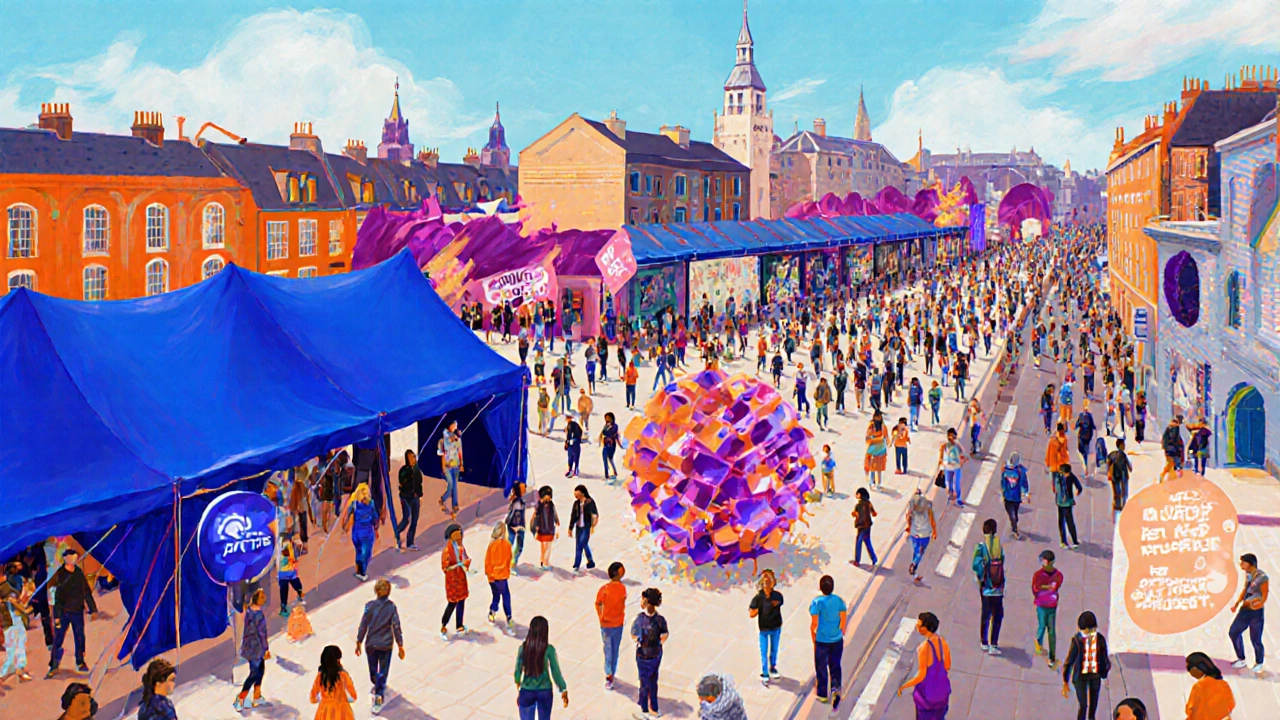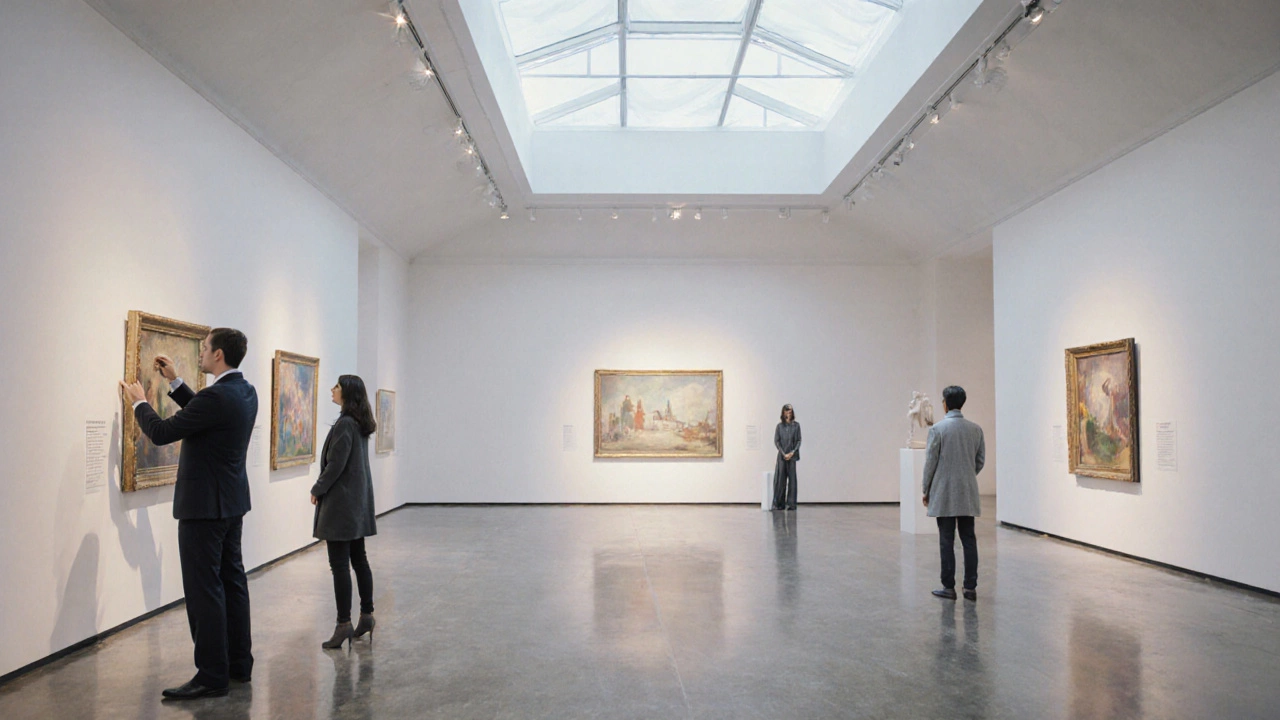Art Exhibit vs Exhibition: Quick Quiz
Your Results:
Ever wondered why some people say "art exhibit" while others talk about an "art exhibition"? The two phrases sound alike, but they serve different roles in the art world. Below is a quick snapshot of what sets them apart, followed by a deep dive that clears up confusion and gives you practical tips for using each term correctly.
- Art exhibit usually refers to a specific collection of works on view, often within a larger venue.
- Art exhibition describes the organized event that brings together one or more exhibits for public viewing.
- Exhibits can be temporary or permanent; exhibitions are generally time‑bound events.
- Curators plan exhibits; exhibition teams handle logistics, marketing, and programming.
- Knowing the difference helps you write clearer press releases, tickets, and social media posts.
What an "art exhibit" actually is
When you first encounter the term, think of a tangible group of artworks displayed together. In formal writing, the definition can be framed like this:
Art exhibit is a curated collection of visual works-paintings, sculptures, photographs, or installations-presented together in a single space. It often focuses on a theme, an artist, or a specific medium.
Key attributes of an art exhibit include:
- Scope: Usually limited to a single gallery room or a defined area within a museum.
- Duration: Can be permanent (like a permanent collection piece) or short‑term (a three‑month showcase).
- Curatorial intent: The curator selects and arranges works to tell a story or explore a concept.
For example, the Tate Modern’s “Dalí: The Surreal World” was an art exhibit that occupied one floor for six months, letting visitors walk through a chronological journey of Dalí’s paintings and drawings.
What an "art exhibition" actually is
An exhibition is the broader event that may host one or many exhibits. You can think of it as the umbrella under which individual exhibits sit.
Art exhibition is a planned, time‑limited public event that brings together artworks-often across multiple venues or galleries-to showcase a theme, a movement, or a group of artists. It involves programming, marketing, ticketing, and visitor services.
Typical attributes of an exhibition include:
- Scale: Can span an entire museum, a city‑wide circuit, or even multiple countries.
- Timeline: Usually runs for a set period, ranging from a weekend pop‑up to a year‑long retrospection.
- Production team: Beyond curators, exhibitions rely on designers, educators, PR staff, and facilities managers.
A well‑known example is the "Van Gogh Alive" traveling exhibition, which combined several immersive art exhibits, film projections, and interactive stations under one event banner.
Side‑by‑side comparison
| Aspect | Art Exhibit | Art Exhibition |
|---|---|---|
| Definition | Curated collection of works displayed together | Time‑bound public event that may house one or many exhibits |
| Typical Size | Single room or defined space | Entire venue, multiple venues, or city‑wide |
| Duration | Permanent or short‑term | Usually limited (weeks‑to‑months) |
| Key Players | Curator, artist | Curator, designer, marketer, educators, facilities staff |
| Purpose | Showcase specific works or theme | Engage public, generate revenue, raise profile of a movement/artist |
| Examples | "The Blue Period" exhibit at MoMA | "Impressionism: Journey of Light" traveling exhibition |
Why the confusion persists
Both words share the root “exhibit,” which means “to display.” Over time, marketing teams and journalists have blurred the line, using them interchangeably. Here are three common scenarios that fuel the mix‑up:
- Press releases: A museum might announce "Our new art exhibition opens next month," but the actual content is a single exhibit focused on a lone artist.
- Ticketing platforms: Online event pages often label a multi‑venue show as an "exhibit" because the form field is limited.
- Social media hashtags: Instagram users tag #artexhibit and #artexhibition without distinguishing scale, making the terms appear synonymous.
Understanding the subtle distinction helps you write more precise copy and avoid misleading your audience.

How to choose the right term
When you’re drafting a description, ask yourself a few quick questions:
- Is the focus on a single collection of works? Use exhibit.
- Is the event larger, involving multiple collections, locations, or a program of activities? Use exhibition.
- Do you need to convey a limited timeframe? Both can be time‑bound, but "exhibition" more strongly suggests a schedule.
- Are you speaking to a professional audience (curators, donors)? They tend to treat the terms distinctly.
Try swapping the words in a draft sentence. If "exhibit" feels too narrow, upgrade to "exhibition." If "exhibition" sounds grandiose for a modest gallery show, dial back to "exhibit."
Practical examples from around the world
Below are three real‑world cases that illustrate the correct usage.
- London’s Saatchi Gallery hosted the "Future of Portraiture" exhibit. It featured 30 contemporary portraits displayed in a single hall for three months.
- Venice Biennale is an exhibition that runs for six weeks, encompassing dozens of national pavilions, multiple curatorial essays, and performance art programs.
- Brooklyn’s BRIC Arts organized the "Street Art Summer" exhibit, a temporary outdoor installation of murals. The city‑wide event that promoted the exhibit was marketed as an exhibition.
Notice how each institution distinguishes the internal collection (exhibit) from the public-facing program (exhibition).
Common pitfalls and how to avoid them
Even seasoned writers slip up. Keep these traps in mind:
- Calling a permanent collection an exhibit: Permanent galleries are usually referred to as "collections" or "permanent exhibitions," not as temporary exhibits.
- Using "exhibition" for a single artwork display: If you’re showing only one piece, call it a "solo exhibit" rather than an "exhibition."
- Mixing the terms in a single sentence: "Our exhibition features an exhibit of kinetic sculptures" can be clunky. Instead, "Our exhibition includes a kinetic‑sculpture exhibit."
Proofread specifically for these mix‑ups; a quick checklist can save you embarrassment.
Quick checklist for writers, marketers, and curators
- Identify the scope: single collection (exhibit) vs. programmatic event (exhibition).
- Confirm duration: permanent vs. limited timeframe.
- Determine audience: professionals may expect precise terminology.
- Choose the term that matches the scale and intent.
- Run a final read‑through focusing on the words "exhibit" and "exhibition" to ensure consistency.
Following this list guarantees clear communication across press releases, signage, and social media.
Frequently Asked Questions
Is an "art exhibit" always part of an "art exhibition"?
Not necessarily. A stand‑alone exhibit can live within a museum’s permanent collection, while an exhibition typically bundles one or more exhibits under a time‑limited program.
Can a traveling show be called an exhibit?
When the traveling show focuses on a single curated set of works, it’s accurate to call it an exhibit. However, the overall tour is marketed as an exhibition because it involves multiple venues and dates.
Do museums use the terms interchangeably?
Many institutions blur the line in public‑facing language, but internally they maintain a distinction for budgeting, staffing, and curatorial records.
Which term is better for SEO?
Both rank well, but using the precise term that matches user intent (e.g., "art exhibit schedule" vs. "art exhibition tickets") can improve click‑through rates and reduce bounce.
How do these terms affect ticket pricing?
Exhibitions often include additional programming-talks, workshops, and merchandise-so ticket bundles may be priced higher than a simple exhibit admission.

